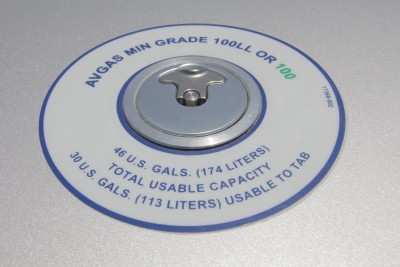Sat, Sep 24, 2011
Maximum Lead Content Is Reduced By 19% In New Fuel
 The FAA has issued a Special Airworthiness
Information Bulletin (SAIB) indicating that grade 100VLL aviation
gasoline meeting the American Society for Testing and Materials
(ASTM) fuel specification D910 is acceptable for use on aircraft
and engines certificated for operation with D910 grades 80, 91,
100, and 100LL aviation gasolines. Grade 100VLL meets all the
performance requirements of grades 80, 91, 100, and 100LL and
therefore meets the approved operating limitations for aircraft and
engines certificated to operate with these other grades of aviation
gasoline.
The FAA has issued a Special Airworthiness
Information Bulletin (SAIB) indicating that grade 100VLL aviation
gasoline meeting the American Society for Testing and Materials
(ASTM) fuel specification D910 is acceptable for use on aircraft
and engines certificated for operation with D910 grades 80, 91,
100, and 100LL aviation gasolines. Grade 100VLL meets all the
performance requirements of grades 80, 91, 100, and 100LL and
therefore meets the approved operating limitations for aircraft and
engines certificated to operate with these other grades of aviation
gasoline.
The FAA relies on ASTM International to develop fuel
specifications that applicants may designate as operating
limitations for their approved products. These aviation fuel
operating limitations may be listed in the product’s Type
Certificate Data Sheet (TCDS), Installation Manual, service
instructions, or as limitations associated with a Supplemental Type
Certificate (STC).
Grade 100VLL aviation gasoline (avgas) was developed by ASTM
International to provide a lower-lead alternative to 100LL in
response to impending environmental regulations. Grade 100VLL is
identical to 100LL in all aspects, except that the maximum lead
content is reduced by about 19%. The specification criteria for
lead content is expressed as only a maximum value, because avgas
producers routinely tradeoff lead content with other fuel
compositional changes to meet the specification criteria for Motor
Octane Number (MON). FAA survey data has shown that the lead
content can vary by up to 39% from the maximum lead value listed in
the specification while still meeting the MON minimum requirement.
Consequently, and most importantly, grade 100VLL has the same
minimum octane rating and will provide the same level of anti-knock
performance as 100LL and 100 avgas grades.

The FAA collaborated with industry on the ASTM International
task force that evaluated data supporting the incorporation of
grade 100VLL into specification D910. The FAA determined that grade
100 VLL meets all of the performance requirements of grades 80, 91,
100, and 100LL and will perform identically in existing aircraft
and engines.
Because grade 100VLL avgas that meets ASTM specification D910 is
identical to grade 100LL avgas, the following recommendations
apply:
- Grade 100VLL avgas is acceptable for use on those aircraft and
engines that are approved to operate with grades 80, 91, 100, or
100LL avgas.
- ASTM International standard D910 specifies blue coloration for
both grade 100VLL avgas and grade 100LL avgas, and, therefore,
these fuels are visually indistinguishable from each other.
- Operating limitations in Aircraft Flight Manuals, Pilot
Operating Instructions, or TCDSs that specify grades 80, 91, 100,
or 100LL avgas fuel are acceptable for use with grade 100VLL
avgas.
- Current aircraft placards that specify grades 80, 91, 100, or
100LL avgas are acceptable for use with grade 100VLL avgas.
- Operating, maintenance, or other service documents, for
aircraft and engines that are approved to operate with grades 80,
91, 100, or 100LL avgas, are acceptable for use when operating with
grade 100VLL avgas.
More News
Maximum Authorized Altitude A published altitude representing the maximum usable altitude or flight level for an airspace structure or route segment. It is the highest altitude on >[...]
Aero Linx: Soaring Safety Foundation (SSF) The Soaring Safety Foundation (SSF) is the Training and Safety arm of the Soaring Society of America (SSA). Our mission is to provide ins>[...]
From 2013 (YouTube Version): Dracula Lives On Through Kyle Franklin... and We're NOT Scared! ANN CEO and Editor-in-Chief, Jim Campbell speaks with Aerobatic and airshow master, Kyl>[...]
“For Montaer Aircraft it is a very prudent move to incorporate such reliable institution as Ocala Aviation, with the background of decades in training experience and aviation>[...]
Also: ForeFlight Upgrades, Cicare USA, Vittorazi Engines, EarthX We have a number of late-breaking news highlights from the 2024 Innovation Preview... which was PACKED with real ne>[...]
 ANN's Daily Aero-Term (04.14.24): Maximum Authorized Altitude
ANN's Daily Aero-Term (04.14.24): Maximum Authorized Altitude ANN's Daily Aero-Linx (04.14.24)
ANN's Daily Aero-Linx (04.14.24) Classic Aero-TV: 'We're Surviving'-- Kyle Franklin Describes Airshow Life 2013
Classic Aero-TV: 'We're Surviving'-- Kyle Franklin Describes Airshow Life 2013 Aero-News: Quote of the Day (04.14.24)
Aero-News: Quote of the Day (04.14.24) Airborne 04.09.24: SnF24!, Piper-DeltaHawk!, Fisher Update, Junkers
Airborne 04.09.24: SnF24!, Piper-DeltaHawk!, Fisher Update, Junkers




